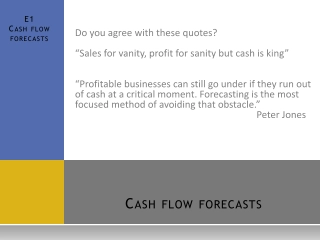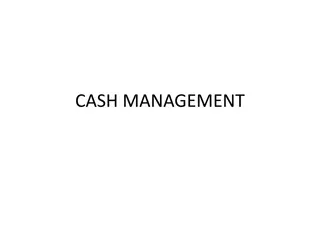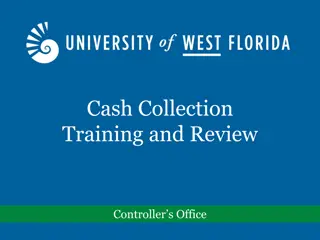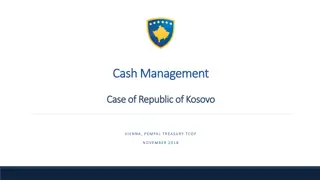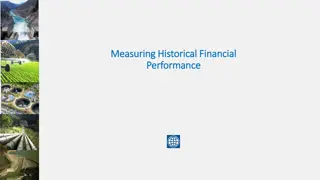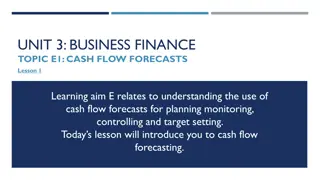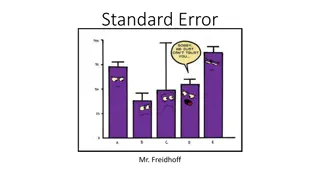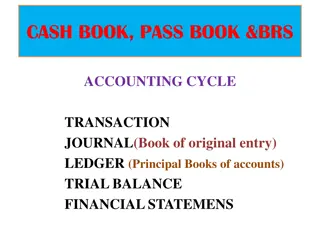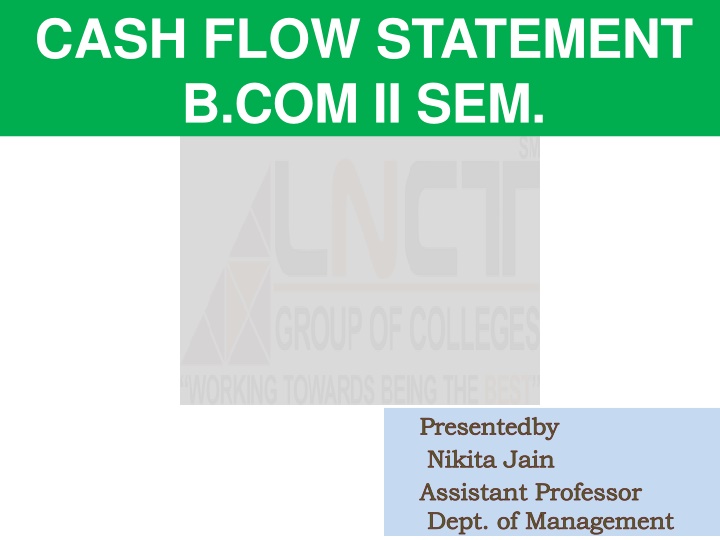
Cash Flow Statement in Business Operations
Explore the significance of cash flow statements in managing cash balances, analyzing financial performance, and aiding decision-making. Learn about the purpose, benefits, limitations, and objectives of cash flow statements.
Download Presentation

Please find below an Image/Link to download the presentation.
The content on the website is provided AS IS for your information and personal use only. It may not be sold, licensed, or shared on other websites without obtaining consent from the author. If you encounter any issues during the download, it is possible that the publisher has removed the file from their server.
You are allowed to download the files provided on this website for personal or commercial use, subject to the condition that they are used lawfully. All files are the property of their respective owners.
The content on the website is provided AS IS for your information and personal use only. It may not be sold, licensed, or shared on other websites without obtaining consent from the author.
E N D
Presentation Transcript
CASH FLOW STATEMENT B.COM II SEM. Presentedby Nikita Jain Assistant Professor Dept. of Management
Introduction Cash plays a very important role in the economic life of a business. A firm needs cash to make payment to its suppliers, to incur day-to-day expenses and to pay salaries, wages, interest and dividends etc. In fact, what blood is to a human body, cash is to a business enterprise. Thus, it is very essential for a business to maintain an adequate balance of cash. For example, a concern operates profitably but it does not have sufficient cash balance to pay dividends, what message does it convey to the shareholders and public in general. Thus, management of cash is very essential.
Cash flow statement Cash flow statement provides information about the cash receipts (Inflows) and payments (outflows) of a firm for a given period. It is a statement depicting change in cash position from one period to another. For example, if the cash balance of business is shown by its Balance sheet on 31st December, 2012 at Rs. 20,000 while the cash balance as per its balance sheet on 31st December, 2013 is Rs. 30,000. There has been an inflow of cash of Rs. 10,000 in the year 2013 as compared to the year 2012. It explains the reasons for such inflows or outflows of cash, as the case may be. It also helps management in making plans for the immediate future.
Purpose of the Statement To provide relevant information about the cash receipts and cash payments of an enterprise during a period. The statement provide answers to the following questions: 1. Where did the cash come from? 2. What was the cash used for? 3. What was the change in the cash balance?
Why c a s h f l o w A n a l y s i s ??? Its an important analytical tool for creditors, investors and other users of financial statement data. Firm s ability to generate cash flows in the future Firm s capacity to meet cash obligations Firm s future external financing needs success in productively managing investing Firm s activities Firm s effectiveness in implementing financing and investing strategies
Objectives of Cash Flow Statement Helpful in the formation of policies
Cash Flow Statement : Limitations Does not show the liquidity position of the firm because an income statement takes into account both cash as well as non-cash items. It is not a substitute of income statement. Does not show the financial position of the firm in totality
Distinction between Cash flow Statement and Funds Flow Statement Cash Flow Funds Flow Basis f Difference It is based uponaccrual Basis of accounting I.e Workingcapital It recognizes Cash basis Of accounting Basis of Accounting It is useful for short- Term financialplanning It is useful for long-term Financial planning Significance Schedule of Changes in WorkingCapital Such a schedule is not Prepared for preparing Cash flowstatement Schedule of changes in Working capital is Prepared separately It studies onlythe Causes of cash variation Causes of Variation It studies causes of change in workingcapital
Classification of Cash Inflows and Outflows
Operating activities It includes receiving cash from customers for the sale of goods and services, receiving interest and dividends on loans and investments, and making cash payments for wages, goods and services purchased, interest, and taxes. Operating Activities Cash Inflow Cash Outflow 1) Cash Purchases 2) Payment to Creditors 3) Cash Operating Expenses 4) Payment of Wages 5) Income Tax 6) Manufacturing Expenses 1) Cash Sales 2) Received from Debtor 3) Commission & Fees 4) Royalty Cash effects the transaction on Net Income
Calculation Of Net Cash Flow from Operating Activities (Direct Method) Rs. Rs. xxx xxx xxx xxx xxx Total Sales Add: Opening balance of Receivables (Debtors + B/R) Less: Closing balance of Receivables (Debtors + B/R) Cash receipts from customers Less: Cash paid to suppliers and Employees: Cost of goods sold Add: Stock at the end xxx xxx xxx xxx xxx xxx xxx xxx xxx xxx Less: Stock at the beginnning Total Purchases Add: Opening balance of Payables (Creditors + B/P) Less: Closing balance of Payables (Creditors + B/P) Cash paid by the suppliers Add: Cash Operating expenses Cash generated from Operating Activities Less: Income tax paid Net Cash Flow From Operating Activities xxx xxx xxx xxx
Calculation Of Net Cash Flow from Operating Activities (InDirect Method) Rs. Rs. Xxx Net Profit before tax Add: Non Cash and Non Operating charges : Depreciation Goodwill written off Preliminary expenses written off Discount on shares/Debentures written off Loss on sale of Fixed or non current assets/ Inventories Transfer to reserves xxx xxx xxx xxx xxx xxx Xxx Xxx Less: Non Cash and Non Operating credits: Profit on sale of Fixed or non current assets/ Inventories Interest Received Dividend Received Operating Profit before Working Capital changes Add: Decrease in Current Assets Increase in Current Liabilities xxx xxx xxx Xxx Xxx xxx xxx Xxx Xxx Less: Increase in Current Assets Decrease in Current Liabilities Cash generated from Operating Activities Less: Income tax paid Extraordinary items xxx xxx Xxx Xxx xxx xxx Xxx Xxx Net Cash Flow From Operating Activities
Investing activities It includes purchasing and selling long-term assets and marketable securities (other than cash equivalents), as well as making and collecting on loans. Investing Activities Cash Inflow Cash Outflow 1)Sale of Fixed Assets 2)Sale of investments 3)Interest Received 4)Dividend Received 5)Working Capital Recovery 1)Purchase of Fixed Assets 2)Purchase of Investments 3)Working Capital
Calculation Of Net Cash Flow from Investing Activities Rs. Rs. Particulars Add: Sale of Fixed or Non Current Assets xxx Sale of Long Term or Non Current Investments xxx Interest received on investment xxx Dividend received xxx Rent from property let out xxx Insurance claims recovered for loss of fixed assets Less: Purchase of Fixed or Non Current Assets xxx xxx xxx Purchase of Long Term or Non Current Investments Capital gains tax paid xxx xxx xxx Net Cash Flow From Investing Activities xxx
Question: A Company had the following balances: Investment as on 31.3.2014 Investment as on 31.3.2015 Rs. 68,000 Rs. 56,000 During the year the company had sold 40% of its investment held in the beginning of the period of Rs.16,800. Calculate Cash flow from Investing activities.
Solution Calculation of Cash Flow from Investing Activities Particulars Rs. Rs. Inflow from sale of Investment: Cost of Investment sold(40% of Rs. 68,000) 27,200 Add: Profit on sale 16,800 44,000 Outflow on Purchase of Investment (Note 1) (15,200) Net Cash Flow from Investing Activities 28,800 Note 1 Investment Account Particulars Amount Particulars Amount To Bal b/d 68,000 By Bank a/c (Sale of Investment) 44,000 To statement of P&L 16,800 By Balance c/d 56,000 To Bank a/c (Purchase of Investment) 15,200 1,00,000 1,00,000
Question From the following information calculate the amount of net cash flow from the Investing activities: Particulars 31.3.2015 (Rs.) 31.3.2016 (Rs.) Land 3,00,000 1,00,000 Plant and Machinery Long term Investments 8,00,000 10,00,000 50,000 1,00,000 Additional information: (1)Plant and machinery has been charged a depreciation of Rs. 80,000 (2)Plant and machinery with a book value of Rs. 1,00,000 was sold for Rs. 1,20,000 (3)Land was sold at a profit of Rs. 50,000
Solution Calculation of Cash Flow from Investing Activities Particulars Rs. Rs. Add: Cash receipts from sale of Plant & Machinery 1,20,00 0 Cash receipts from sale of Land (3,00,000-1,00,000+50,000) 2,50,00 0 3,70,000 Less: Cash payment to purchase of Plant & Machinery (Note 1) 3,80,00 0 Cash payment to acquire Investment (1,00,000-50,000) 50,000 (4,30,000) Net Cash Flow from Investing Activities Note 1 (60,000) Plant & Machinery Account Particulars Amount Particulars Amount To Bal b/d 8,00,000 By Bank a/c (Sale of Plant) 1,20,000 To statement of P&L 20,000 By Depreciation a/c 80,000 To Bank a/c (Purchase of Plant) 3,80,000 By Balance c/d 10,00,000 12,00,000 12,00,000
Financing activities It includes issuing and buying back capital stock, as well as borrowing and repaying loans on a short- or long-term basis (issuing bonds and notes). Dividends paid are also included in this category. Financing Activities Cash Inflow Cash Outflow 1)Issue of Shares in Cash 2)Issue of Debentures in Cash 3)Proceeds from long- term borrowings 1)Payment of Loans 2)Redemption of Preference Shares 3)Payment of Dividends 4)Interest Paid 5)Repayment of Finance/ Lease Liability
Calculation Of Net Cash Flow from Financing Activities Rs. Rs. Particulars Issue of Share Capital xxx Add: Proceeds from issue of debentures or Long term borrowings Less: Redemption of Preference Shares xxx xxx xxx Repayment of Debentures or Long term borrowings xxx Interest on Debentures or Long term borrowings xxx Dividend on shares xxx xxx Net Cash Flow From Investing Activities xxx
Question From the following information calculate the amount of net cash flow from the Financing activities: Particulars 31.3.2015 (Rs.) Equity Share Capital 3,00,000 Preference Share Capital 10% Debentures 2,00,000 Share Premium Reserve Additional Information : Dividend paid on shares Rs. 15,000 Interest paid on debentures Rs.20,000 31.3.2016 (Rs.) 4,00,000 60,000 1,00,000 1,00,000 40,000 30,000
Solution Calculation of Net Cash Flow from Financing Activities Particulars Cash proceeds from Issue of Equity shares(including share premium) Cash payment in Redemption of Preference shares Cash Repayment of Debentures Cash payment of Dividend Rs. Rs. 1,10,000 (40,000) (1,00,000) (15,000) Cash payment of Interest Net Cash Flow from Financing Activities (20,000) (65,000)
Question From the following information calculate the amount of net cash flow from the Financing activities: Particulars 31.3.2016 (Rs.) Equity Share Capital 4,00,000 31.3.2017 (Rs.) 6,00,000 1,00,000 ------------- 10% Debentures 8% Debentures Additional Information : Dividend paid on shares Rs. 40,000 Interest paid on debentures Rs. 13,000 ---------------- 2,00,000
Solution Calculation of Net Cash Flow from Financing Activities Particulars Cash proceeds from Issue of Equity shares(including share premium) Cash Repayment of 10% Debentures Rs. Rs. 2,00,000 (1,00,000) Cash proceeds from issue of 8% Debentures Cash payment of Dividend 2,00,000 (40,000) Cash payment of Interest Net Cash Flow from Financing Activities (13,000) 2,47,000
FORMAT OF CASH FLOW STATEMENT As per AS-3, the format of Cash Flow Statement is as follows: Cash Flow Statement AsS-3 DIRECT METHOD Particulars Cash Flow from Operating Activities: Cash Receipts from Customers Cash Paid to Suppliers and Employees Taxes Paid Other Receipts Rs. Rs. xxx (xxx) (xxx) xxx xxx Net Cash Flow From Operating Activities Cash Flow From Investing Activities: Purchase of Fixed or Non Current Assets Sale of Fixed or Non Current Assets Interest received on investment Dividend received (xxx) xxx xxx xxx Net Cash Used In Investing Activities xxx Cash Flow from Financing Activities: Issue of Share Capital Long term borrowings taken Repayment of Loans Interest paid Dividend paid xxx xxx (xxx) (xxx) (xxx) Net Cash Flow Used In Financing Activities Net Increase in Cash and Cash Equivalents Cash and Cash Equivalents in the beginning Cash and Cash Equivalents in the end xxx Xxx Xxx xxx
Question st march, 2014 and 2015 are as follows: 31.3.2014 The Balance Sheet of Priya Ltd. As on 31 Particulars I. Equity & Liabilities Shareholder's fund: Share Capital Retained Earnings Non Current Liabilities: 10% Debentures Current Liabilities: Trade Payables 31.3.2015 1,00,000 70,250 1,60,000 85,300 50,000 28,000 2,48,250 48,000 2,93,300 II. Assets Non Current Assets: Fixed Assets Less: Accumulated depreciation 1,52,000 60,000 92,000 2,00,000 40,000 1,60,000 Current Assets: Inventories Trade Receivables Prepaid Expenses Bank 93,400 30,800 3,950 28,100 2,48,250 89,200 21,100 3,000 20,000 2,93,300
The following additional information for the year 2014-2015 is also available: (a) Net Profit Rs. 27,050 (b)Depreciation charge Rs. 10,000 (c)Cash dividend declared during the period Rs. 12,000 (d) An addition to the building was made during the year at a cost of Rs. 78,000 and fully depreciated equipment costing Rs. 30,000 was discarded, no salvage being realised. Prepare a Cash Flow Statement.
Solution Cash Flow Statement (for the year ended 31st March,2015) Particulars Cash Flow from Operating Activities: Net Profit Adjustment for: Depreciation Operating Profit before Working Capital Changes Decrease in inventory (93,400-89,200) Decrease in Trade Receivables (30,800-21,100) Decrease in Prepaid expenses (3,950-3000) Increase in Trade Payables (48,000-28,000) Net Cash Flow From Operating Activities Cash Flow From Investing Activities: Purchase of Building Net Cash Used In Investing Activities Cash Flow from Financing Activities: Issue of Share Capital Redemption of 10% Debentures Dividend paid Net Cash Flow Used In Financing Activities Net Decrease in Cash Cash at the beginning Cash at the End Rs. Rs. 27,050 10,000 37,050 10,000 4,200 9,700 950 20,000 34,850 71,900 (78,000) (78,000) 60,000 (50,000) (12,000) (2,000 (8,100) 28,100 20,000
Question Prepare Cash Flow Statement from the following information: Rs. Opening cash balance 4,50,000 Closing cash balance 88,800 Net profit for the year 1,00,000 Repayment of long term loan 15,00,000 Sale of fixed assets 9,00,000 Increase in debtors 40,500 Decrease in creditors 28,700 Decrease in stock 2,40,000 Non operating expenses 1,25,000 Non operating income 30,000 Income tax paid 1,27,000
Solution Cash Flow Statement Rs. Rs. Particulars Cash Flow from Operating Activities: Profit for the year Add: Non Operating Expenses 1,00,000 1,25,000 2,25,000 (30,000) 1,95,000 2,40,000 4,35,000 Less: Non Operating Income Operating profit before Working Capital Changes Add: Decrease in Stock Less: Increase in Debtors 40,500 Decrease in Creditors 28,700 Net Cash Flow From Operating Activities Less: Income tax paid Cash Flow From Investing Activities: Sale of fixed assets Net Cash Used In Investing Activities Cash Flow from Financing Activities: Repayment of Long term loan Net Cash Flow Used In Financing Activities Net Decrease in Cash Cash at the beginning Cash at the End (69,200) 3,65,800 (1,27,000) 2,38,000 9,00,000 9,00,000 (15,00,000) (15,00,000) (3,61,200) 4,50,000 88,800
Question Prepare Cash Flow Statement from the following information: Rs. Cash from operation 50,000 Sale of fixed assets 7,60,000 Issue of shares for cash 5,00,000 Increase in Currents assets 1,00,000 Increase in Current liabilities 60,000 Decrease in Current assets 70,000 Decrease in Current liabilities 40,000 Repayment of loan taken 4,00,000
Solution Cash Flow Statement Particulars Rs. Rs. Cash Flow from Operating Activities: Cash from operation Increase in Current Assets Increase in Current Liabilities Decrease in Current Assets Decrease in Current Liabilities Net Cash Flow From Operating Activities Cash Flow From Investing Activities: Sale of fixed assets Net Cash Used In Investing Activities Cash Flow from Financing Activities: Issue of shares Repayment of Long loan Net Cash Flow Used In Financing Activities Net Increase in Cash 50,000 (1,00,000) 60,000 70,000 (40,000) 40,000 7,60,000 7,60,000 5,00,000 (4,00,000) 1,00,000 9,00,000
By Prof. Nikita Jain B.Com, PGDCA, MBA Assistant Professor Dept. Of Management LNCT Bhopal

